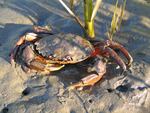Invasive species are non-native species whose introduction does, or is likely to, cause economic or environmental damage or harm to human health. That's a fancy way of saying these are critters and weeds we don't want around.
More than 50,000 non-native species have been introduced to the United States throughout our history. They arrive in ballast water, hitch a ride on vehicles and accompany passengers on planes. Some are even introduced on purpose, such as for erosion control, as landscape plants for gardens or as exotic pets. Most any pathway that people use to get from place to place, exotic species can use as well. Fortunately, only a small fraction of introduced species become invasive. In fact most of these non-natives have been beneficial. For example, corn, wheat, rice, and other essential food crops along with poultry, cattle, and other livestock were all introduced species — but they're not invasive.
Consequences
The Environmental Protection Agency estimates that the economic and environmental damage from invasive species is costing the United States more than $138 billion per year. That's $500 per person per year. But even those numbers don't speak to the long-term and irreversible cost everyday, precious wildlife and natural areas are disappearing because of invasive species.
Almost 50% of the species on the threatened or endangered listing are there because of the direct impact of non-indigenous species. Across the country, boaters are facing lakes closed to recreational use as the result of invasive plants. Homeowners are finding houses destroyed by Subterranian Fermosan termites. Here in Oregon, hikers find English Ivy suffocating their favorite parks and cheatgrass is transforming the natural fire cycles of the desert. Out at sea, Dungeness crab territory is being invaded by Green crabs.

European green crab, Puget Sound in Washington state.
Sean McDonald / Washington Sea Grant
The impact of different invasive species in an area can vary significantly. Many are merely a nuisance. Others take over limited areas and compete with native species for resources. There are handful of dangerous and aggressive invaders whose introduction to an area can cause complete devastation. These are the bullies in the native landscape, using a welcoming climate and a lack of natural predators to push everything else out. In California, one invasive plant, Yellow Star Thistle, now dominates more than 19 million acres, an area roughly the size of 4,000 Forest Parks. Such vast infestations create ecological deserts where the natural diversity gets wiped out by the more aggressive and successful invader.
Why Now?
After centuries of people traveling from one place to another and transporting invasive species with them, does any of this really matter? Why not just let nature take its course? The reality is that long-distance travel is easier and more common than ever, which means we're transporting more invasive species than ever before. Quietly but consistently, these invasives are threatening native species, consuming our natural areas, infesting our gardens and making us all pay for the consequences. Increasing our awareness and vigilance as we travel and move goods around the planet will help stem the tide of invasive species and save us money and natural resources in the long run. And there are many organizations throughout the state, the country, the world, making change happen now.
Turning The Tide
With a problem this big, it might appear there's nothing we as individuals can do to prevent the inevitable. What we discovered while making "The Silent Invasion" is that the opposite is true — the actions of individuals are crucial to stopping the spread of invasive species and are our greatest reason for hope. Individuals can make simple changes that can effectively block the pathways of invasion. Individuals can be the eyes in the field for identifying new outbreaks and controlling them before they get established. And individuals can lend a hand to eradicate established invaders and reclaim our native landscapes. All of us play a role in this problem and all of us can be part of the solution.
